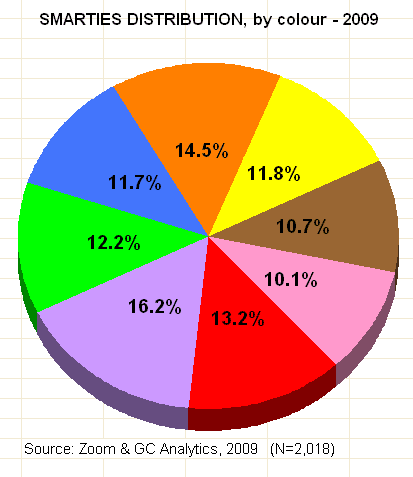Bad news for all you Jewish vegetarians: Smarties are neither vegetarian nor kosher!
Purple Smarties are dyed with cochineal (carminic acid), which is made from ground-up pregnant Cochineal insects. Because of this, Smarties cannot be considered either vegetarian or kosher, or, for that matter, particularly appetizing.
In 2004, The Vegetarian Society declared Smarties the winner of its Imperfect World Award at a ceremony in London.
Smarties have been around since 1882. There used to be a light brown Smartie, which was coffee-flavoured and which was my favourite member of the Smarties family, but which was discontinued and replaced with the blue Smartie in 1988. Even though blue is my favourite colour in general, I never really accepted the blue Smartie.
The new edition of Smarties, launched just last month, contains no blue or green Smarties. The reason for this is that Nestle has switched to all-natural dyes and is having trouble finding a natural blue dye. (And, because green is made from blue and yellow, green had to be eliminated too.) Many of the remaining six colours are muted versions of their former selves. I’ve seen them and I’m disappointed.
My favourite Smartie is the Pink one, but I’ve long suspected that Nestle skimps on the Pinks. After months of painstaking research, I finally have enough evidence to confront Nestle.
GC and I have been tracking Smarties colours in a spreadsheet for the past couple of months. We’ve eaten over 2,000 of the old Smarties in the name of science. Every single one of those Smarties has been entered into our database.
Our results might astound you.
An even distribution would have resulted in each colour of Smarties claiming 12.5% of the total. In our study, the percentages ranged from a low of 10.1% (Pink) to a high of 16.2% (Purple). There are 60% more Purple Smarties than Pink Smarties!
We believe this to be a statistically significant finding, and we’re going to be contacting Nestle for an explanation. We’ll keep you posted.

















Are your Smarties different than the ones sold in the US? Where are the white ones? Those are my favorite. I’m confused! Post a picture of your Smarties!
I don’t suppose it has ever occurred to you that you might have too much time on your hands.
I am now absolutely convinced that you and GC have found your true soul mates. Who else would have embarked on such a project?!
I. am. truly. astounded. Do you think they put fewer pinks ones so that real men won’t be put off by too high a number of pink Smarties in their box? What about M&Ms? Is an analysis of the percentages of each colour found in a packet your next study? And more importantly, how many calories have you consumed for the sake of science? Will you be asking for compensation? Will you be using test subjects? Will you be starting a protest against the presence of red Smarties or will you be demanding thre return of the light brown Smartie?
Thanks for giving me a laugh today, I’ve had a really shitty week-end and I needed to lighten up!
They’ve gotten rid of blue and green??? Blasphemy I tell you!!! (Okay, so I’m too young to remember coffee flavoured ones, but that’s just as well, because I probably would have loathed them)
Mmmm, smarties! Do you chomp them, or try and wait for the candy shell to melt as much as possible? I try to wait, but often end up crunching!
I am thinking though, that purple smarties are a combination of Blue and Red…so why soooo many purple.
Oh, nooooo!!! Smarties contain former living things?
I’m a vegan – almost. Smarties I simply canna do without. My one consolation: my indulgence included no dead things, just milk chocolate. Now my life will never be the same…
My goodness. I think you would have done well in my high school statistics class. I had to do a statistical analysis of M&Ms using color, diameter, and mass.
Are the different colored Smarties supposed to taste different? I’m convinced they do, but I’m sure that’s all in my head. But after eating so many of them, have you noticed anything?
I didn’t realize Smarties were Nestle products. That’s a pretty good reason to me not to buy them anymore, since Nestle was responsible for the formula starvation deaths of many infants in Africa and possibly elsewhere.
Have you guys ever thought about maybe engaging in some horizontal mambo to pass the time like regular couples?
Hmmm… not too sure how this pertains to me as I am not a vegetarian nor do I keep Kosher. In fact, I often chose M&Ms over Smarties. Still… that is some interesting information… might come in handy.
I can’t do Smarties . . . because of the Nestle thing.
Casual Perfectionist, I believe our Canadian Smarties are similar to your M&Ms and your American Smarties are known as our Rockets.
Bandobras, quite the contrary! There’s never enough time.
Oma, you’ve got a point. Not only does GC go along with my ideas, he thinks they’re all brilliant and worth pursuing. Plus, he’s got a few of his own, which are equally brilliant.
Manon, further research is definitely required, and you’ve only scratched the surface of the investigative possibilities there. (I’m sorry about your shitty weekend. Smarties always cheer me up when I’m having a bad day.)
Arden, I always have good intentions of allowing them to melt in my mouth, but I haven’t got that kind of impulse control – I almost always end up chomping them.
Deb, in the world of Smarties, purple is not a combination of red and blue – it is a distinct entity, coloured with its own dye (made from crushed pregnant beetles).
Ocean, I’m sorry. I didn’t want to be the one to alert you to your carnivorous ways…perhaps it would be better to live blissfully unaware that one is eating crushed pregnant beetles. (But you know, on average we all inadvertently consume 108 bugs each year, so none of us are absolute vegetarians, right?)
Convivialidell, that’s an excellent question. As I stated earlier, pink is my favourite smartie. Blue is GC’s favourite. One evening, just for fun, we did a blind taste test. Our scores ranked about what would be expected from random guessing. (But I still like the pink ones best and GC still likes the blue ones best, and I still miss the light brown coffee-flavoured ones.)
Saskboy, that’s true, and I boycott all Nestle products too, except for Smarties – I got hooked on Smarties way back when Rowntree owned them and I just can’t give them up.
Grace – and Saskboy too – It seems to me that that whole disaster happened a long time ago and Nestle has been trying to recover from it ever since. I think it’s been at least a decade since they tried to replace African breast milk with formula. Or am I wrong about that?
It would be good to see a formal test for statistical significance, including a p-value.
Also, it would be interesting to know how much variation there is between individual boxes. Do most boxes have colour ratios largely consistent with those above?
http://www.guardian.co.uk/business/2007/may/15/medicineandhealth.lifeandhealth
There are demonstrations set for May 19, 2009. More recent articles are around but the 2007 one above is informative.
I’m such a geek – I just popped it in my stats program – it is statistically significant. More purple than expected.
But I am particularly distressed by the purple smarties business – I always saved them for last. Ugh. I’m sure I’ve eaten worse things, however.
A statistical test of the likelihood that pink Smarties are underrepresented:
If pink smarties make up 10.1% of 2018 Smarties, there must be 204 of them. As such, the question is how likely we are to get 48 fewer pink Smarties than expected, in a sample of this size.
Under the null hypothesis (pinks are equally represented), we would expect to get 252 pinks in a sample of 2018 (2018/8). The relevant standard deviation for calculating a z-score is root(N/8) = 15.88. The 48-Smartie difference is thus 3.03 standard deviations.
The z-score is thus ( 252.25 – 204 ) / 15.88 = 3.038 (ignoring significant figures all the while). That yields a p-value of 0.0024.
It is fair to say that the number of pink Smarties in your sample is less than you would expect if they were evenly distributed in the population of Smarties, with a confidence level of over 99%.
Well I’m glad to see GC and I aren’t the only ones who get off on statistically significant deviance!
cochineal is one of our oldest dye sources – it explains all the beautiful pinks and reds and purples in developing nations fibre art. I am a HUGE fan of cochineal!
Mmmmmmmm, purple Smarties! Sigh!
So you’ve sent me on a Smarties craving, and I got the new ones today. THEY TASTE DIFFERENT!!! They candy coating/colouring has a slightly fruity taste. It’s not right at all. Not too bad if you crunch them down, but if you try and melt them in your mouth it’s just not right
They candy coating/colouring has a slightly fruity taste. It’s not right at all. Not too bad if you crunch them down, but if you try and melt them in your mouth it’s just not right  Not impressed
Not impressed  Plus, if you look at the ingredients, they’re still using artificial flavours so, why not keep on using artificial dies?
Plus, if you look at the ingredients, they’re still using artificial flavours so, why not keep on using artificial dies?
Such is my love for Smarties that even the news about the beetles does not diminish my craving for them.
There’s new reasons to boycott including their attempt at fake corporate responsibility by starting their own fake fair trade label.
Wolfram Alpha can calculate confidence levels and p-values from z-scores. It’s pretty neat, actually.
Hello everybody!
My questions is: did you just randomly take the smarties from all the type of smartie packages that exist? for example there is the big package with 15 small packages in it, then there is the role .. etc. Or from WHERE exactly is this the colour distribution? And the second question how exactly did you calculate this?
statistics? Need an urgent reply! Thanksss ! x
I have just had my first pack of Smarties for a few years and was disappointed by the faded colours. They looked like an original packet of Smarties would look if you left it in a drawer for too long! I wanted to make sure I wasn’t having one of those false memories about childhood sweets (you know, “Creme Eggs used to be massive!”, that kind of thing…) and your website came up on a Google image search. I love the pie chart, excellent piece of research!
But I just wanted to update the page concerning the purple ones being dyed with cochineal. Neither cochineal nor carmine/ carminic acid/ E120 (the name of the dye obtained from the cochineal insects) is mentioned on the ingredients. It seems they’re now making all the colours from “fruit and vegetable concentrates” (the wording on the packet) – including red cabbage, radish, and black carrot. The new blue colour is derived from spirulina. See the little animation on the Smarties home page for more: http://www.smarties.co.uk/home/
As for whether the colours taste different, I think the orange one is the only one that actually has a different flavour these days. They were always my favourite and still are even though they’re not the crazy bright colour they used to be!
We are doing a project on statistics thanks this page really helped.